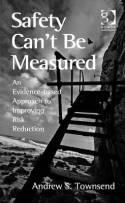The British Prime Minister has avowed to 'kill off the health and safety culture' which he described as 'a monster'. Nonetheless, industries face ever increasing public expectation and legislative pressure to improve safety when, actually, rates of safety improvement have slowed to a standstill. In Safety Can't Be Measured, Andrew Townsend suggests the main reason for the stagnation of safety improvement is the failure to recognise the evolution in accident causation and to evolve with it. He severely criticises some aspects of current day management of occupational safety and contends that everyone is trying to continuously improve something in which improvement cannot be measured, so the received wisdom underpinning safety management and regulation is not evidence-based and much of it is misguided. What is measured is the absence of safety - through incidents, injuries and the occurrence of ill health. We cannot continue to justify these ways of doing things, and claiming success by association, without admitting there might be other explanations. In this series of short chapters, occupational health and safety is put in context by demystifying the research, regulation and management of health and safety. Using evidence, Townsend challenges orthodox dogma by demonstrating that currently unused data could help deduce how safety really works, and thus support alternative thought processes from which new approaches to risk reduction and safety management could emerge
Prologue; Note on methodology; Victims and death and illness in context; Who is who in occupational health and safety; Numbers and meanings; Health and safety law and its enforcement - chimera or ogre?; The concepts of risk, reasonably practicable and reasonably foreseeable; History of accident causation theory; Exploring large organisations - to fear or not to fear?; Health and safety - a profession under scrutiny; Paradoxes and dilemmas; Alternative ways of thinking; Conclusions; Afterword; Index.

 (0 Comentarios)
(0 Comentarios)





